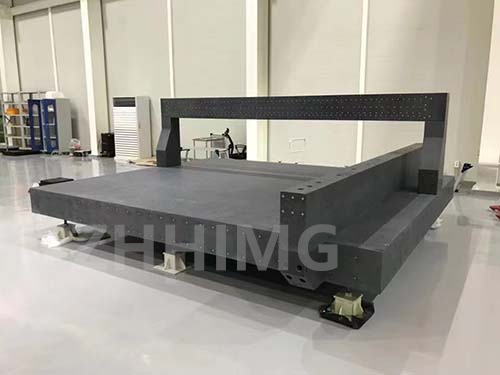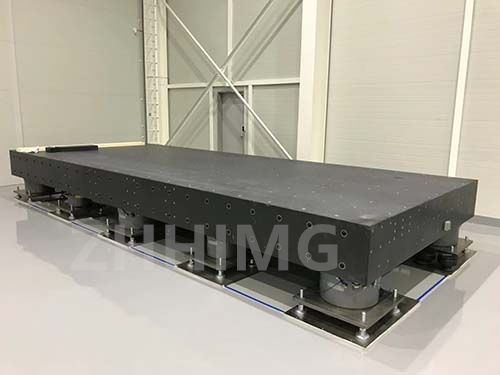In the field of semiconductor manufacturing, as the core equipment that determines the precision of the chip manufacturing process, the stability of the internal environment of the photolithography machine is of vital importance. From the excitation of the extreme ultraviolet light source to the operation of the nanoscale precision motion platform, there can be no slightest deviation in every link. Granite bases, with a series of unique properties, demonstrate unparalleled advantages in ensuring the stable operation of photolithography machines and enhancing photolithography accuracy.
Outstanding electromagnetic shielding performance
The interior of a photolithography machine is filled with a complex electromagnetic environment. Electromagnetic interference (EMI) generated by components such as extreme ultraviolet light sources, drive motors, and high-frequency power supplies, if not effectively controlled, will seriously affect the performance of precision electronic components and optical systems within the equipment. For instance, interference may cause slight deviations in the photolithography patterns. In advanced manufacturing processes, this is sufficient to lead to incorrect transistor connections on the chip, significantly reducing the chip yield.
Granite is a non-metallic material and does not conduct electricity by itself. There is no electromagnetic induction phenomenon caused by the movement of free electrons inside as in metallic materials. This characteristic makes it a natural electromagnetic shielding body, which can effectively block the transmission path of internal electromagnetic interference. When the alternating magnetic field generated by the external electromagnetic interference source propagates to the granite base, since the granite is non-magnetic and cannot be magnetized, the alternating magnetic field is difficult to penetrate, thereby protecting the core components of the photolithography machine installed on the base, such as precision sensors and optical lens adjustment devices, from the influence of electromagnetic interference and ensuring the accuracy of pattern transfer during the photolithography process.

Excellent vacuum compatibility
Because extreme ultraviolet light (EUV) is easily absorbed by all substances, including air, EUV lithography machines must operate in a vacuum environment. At this point, the compatibility of the equipment components with the vacuum environment becomes particularly crucial. In a vacuum, materials may dissolve, desorb and release gas. The released gas not only absorbs EUV light, reducing the intensity and transmission efficiency of the light, but also may contaminate optical lenses. For instance, water vapor can oxidize the lenses, and hydrocarbons can deposit carbon layers on the lenses, seriously affecting the quality of lithography.
Granite has stable chemical properties and hardly releases gas in a vacuum environment. According to professional testing, in a simulated photolithography machine vacuum environment (such as the ultra-clean vacuum environment in which the illumination optical system and imaging optical system in the main chamber are located, requiring H₂O < 10⁻⁵ Pa, CₓHᵧ < 10⁻⁷ Pa), the outgassing rate of the granite base is extremely low, far lower than that of other materials such as metals. This enables the interior of the photolithography machine to maintain a high vacuum degree and cleanliness for a long time, ensuring the high transmittance of EUV light during transmission and an ultra-clean usage environment for optical lenses, extending the service life of the optical system, and enhancing the overall performance of the photolithography machine.
Strong vibration resistance and thermal stability
During the photolithography process, the precision at the nanometer level requires that the photolithography machine must not have the slightest vibration or thermal deformation. Environmental vibrations generated by the operation of other equipment and personnel movement in the workshop, as well as the heat produced by the photolithography machine itself during operation, may all interfere with the photolithography accuracy. Granite has a high density and a hard texture, and it has excellent vibration resistance. Its internal mineral crystal structure is compact, which can effectively attenuate vibration energy and rapidly suppress vibration propagation. Experimental data show that under the same vibration source, the granite base can reduce the vibration amplitude by more than 90% within 0.5 seconds. Compared with the metal base, it can restore the equipment to stability more quickly, ensuring the precise relative position between the photolithography lens and the wafer, and avoiding pattern blurring or misalignment caused by vibration.
Meanwhile, the coefficient of thermal expansion of granite is extremely low, approximately (4-8) ×10⁻⁶/℃, which is much lower than that of metallic materials. During the operation of the photolithography machine, even if the internal temperature fluctuates due to factors such as heat generation from the light source and friction from mechanical components, the granite base can maintain dimensional stability and will not undergo significant deformation due to thermal expansion and contraction. It provides stable and reliable support for the optical system and the precision motion platform, maintaining the consistency of photolithography accuracy.
Post time: May-20-2025

